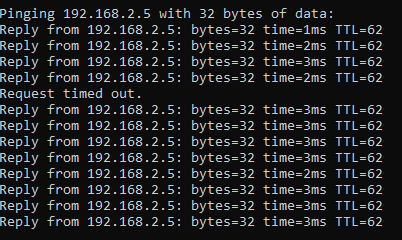OSPF Route Failover New: Difference between revisions
| (58 intermediate revisions by the same user not shown) | |||
| Line 1: | Line 1: | ||
__TOC__ | __TOC__ | ||
<p style="color:red">The information on this page is updated in accordance with the [https://wiki.teltonika-networks.com/view/FW_%26_SDK_Downloads'''00.07.08'''] firmware version.</p> | |||
==Summary== | ==Summary== | ||
In this example we will setup redundant links using dynamic routing where 2 routers will be connected using multiple links directly – Main WAN and two Backup WANs in order to make sure LAN devices on each end would be available in case Main links fail. | In this example we will setup redundant links using dynamic routing where 2 routers will be connected using multiple links directly – Main WAN and two Backup WANs in order to make sure LAN devices on each end would be available in case Main links fail. | ||
== Configuration Overview & Prerequisites== | == Configuration Overview & Prerequisites== | ||
| Line 16: | Line 16: | ||
==Network Topology== | ==Network Topology== | ||
[[File: | [[File:OSPF_WAN_TOPOLOGY_1.png|center|1100px]] | ||
== | ==Configuration Example== | ||
=== | ===Router 1 Configuration=== | ||
---- | ---- | ||
====VLAN Configurtion==== | ====VLAN Configurtion==== | ||
| Line 34: | Line 34: | ||
# VLAN ID: '''172''' | lan1: '''Off''' | Lan2: '''Off''' | Lan3: '''Untagged''' | # VLAN ID: '''172''' | lan1: '''Off''' | Lan2: '''Off''' | Lan3: '''Untagged''' | ||
[[File:OSPF_WAN_1.png|border|class=tlt-border| | [[File:OSPF_WAN_1.png|border|class=tlt-border|1100px]] | ||
====WAN Interface Configurtion===== | ====WAN Interface Configurtion==== | ||
---- | |||
Open router‘s '''WebUI''' and navigate to '''Network → WAN → WAN interfaces''' configuration: | |||
====Creating And Configuring WAN 1 Interface==== | |||
---- | |||
Add new WAN by clicking [[File:Add Button.png|40x70px]] and Make following changes to new interface configurtion: | |||
=====General Settings===== | |||
---- | ---- | ||
Make the following changes: | |||
# Enter Name: '''Wan1Main''' | |||
# Select Protocol: '''Static''' | |||
# Enter IPv4 address: '''192.168.110.1''' | |||
# Enter IPv4 net mask: '''255.255.255.252''' | |||
[[File:OSPF_ROUTER1_WAN1_General.png|border|class=tlt-border|center| 1100px]] | |||
=====Physical Settings===== | |||
---- | |||
Make the following changes: | |||
# Select interface: '''eth0.192''' | |||
[[File:OSPF_ROUTER2_WAN1_Physical.png|border|class=tlt-border|center| 1100px]] | |||
==== | ====Creating And Configuring WAN 2 Interface==== | ||
---- | |||
Add new WAN by clicking [[File:Add Button.png|40x70px]] and Make following changes to new interface configurtion: | |||
=====General Settings===== | |||
---- | ---- | ||
Make the following changes: | |||
# Enter Name: '''Wan2Backup''' | |||
# Select Protocol: '''Static''' | |||
# Enter IPv4 address: '''10.0.110.1''' | |||
# Enter IPv4 net mask: '''255.255.255.252''' | |||
[[File:OSPF_ROUTER1_WAN2_General.png|border|class=tlt-border|center| 1100px]] | |||
=====Physical Settings===== | |||
---- | |||
Make the following changes: | |||
# Select interface: '''eth0.10''' | |||
[[File:OSPF_ROUTER2_WAN2_Physical.png|border|class=tlt-border|center]] | |||
====Creating And Configuring WAN 3 Interface==== | |||
---- | |||
Add new WAN by clicking [[File:Add Button.png|40x70px]] and Make following changes to new interface configurtion: | |||
=====General Settings===== | |||
---- | |||
Make the following changes: | |||
# Enter Name: '''Wan3Backup''' | |||
# Select Protocol: '''Static''' | |||
# Enter IPv4 address: '''172.16.110.1''' | |||
# Enter IPv4 net mask: '''255.255.255.252''' | |||
[[File:OSPF_ROUTER1_WAN3_General.png|border|class=tlt-border|center|1100px]] | |||
=====Physical Settings===== | |||
---- | |||
Make the following changes: | |||
# Select interface: '''eth0.172''' | |||
[[File:OSPF_ROUTER2_WAN3_Physical.png|border|class=tlt-border|center|1100px]] | |||
====OSPF Configuration==== | |||
---- | |||
Open router‘s '''WebUI''' and navigate to '''Network → Routing → Dynamic routes → OSPF''' configuration: | |||
=====OSPF - Global Settings===== | |||
---- | |||
Make following changes: | |||
# Enable Service: '''on''' | |||
# Enable Vty: '''on''' | |||
# Enter Router ID: '''192.168.110.1''' | |||
# Select External Route: '''Default''' | |||
# Select Redistribution Options: '''Connected''' | |||
[[File:OSPF_GLOBAL_ROUTER1.png|border|class=tlt-border|center| 1100px]] | |||
=====OSPF interfaces===== | |||
---- | |||
Add new OSPF interface for each WAN interface created by clicking [[File:Add Button.png|40x70px]] | |||
Make following changes to new interfaces: | |||
# Select Interface: '''eth0.192 (WanMAIN)''' | Enable Interface: '''on''' | |||
# Select Interface: '''eth0.10 (Wan2Backup)''' | Enable Interface: '''on''' | |||
# Select Interface: '''eth0.172 (Wan3Backup)''' | Enable Interface: '''on''' | |||
[[File:OSPF_INTERFACES_1.png|border|class=tlt-border|center| 1100px]] | |||
=== | =====OSPF area===== | ||
---- | ---- | ||
==== | Add new OSPF area for each WAN interface by entering the area name and clicking [[File:Add Button.png|40x70px]] | ||
Make following changes to the areas: | |||
# Name: '''First''' | Area: '''1005''' | Stub: '''off''' | '''on''' | |||
# Name: '''Second''' | Area: '''1004''' | Stub: '''off''' | '''on''' | |||
# Name: '''Third''' | Area: '''1003''' | Stub: '''off''' | '''on''' | |||
[[File:OSPF_AREA_1.png|border|class=tlt-border|center|1100px]] | |||
=====OSPF networks===== | |||
---- | ---- | ||
==== | Add new OSPF network for each WAN interface by entering the area name and clicking [[File:Add Button.png|40x70px]] | ||
Make following changes to the netwroks: | |||
# Name: '''WAN1''' | Network: '''192.168.110.0/30''' | Area: '''First''' | '''on''' | |||
# Name: '''WAN2''' | Network: '''10.0.110.0/30''' | Area: '''Second''' | '''on''' | |||
# Name: '''WAN3''' | Netwrok: '''172.16.110.0/30''' | Area: '''Third''' | '''on''' | |||
[[File:OSPF_NETWORKS_1.png|border|class=tlt-border|center| 1100px]] | |||
===Router 2 Configuration=== | |||
---- | ---- | ||
====VLAN Configurtion==== | |||
---- | |||
Open router‘s WebUI and navigate to '''Network → VLAN → Port Based''' configuration: | |||
=====Port based VLAN===== | |||
---- | |||
Add new VLANs by clicking [[File:Add Button.png|40x70px]] and Make following changes to 3 new VLANS: | |||
# VLAN ID: '''192''' | lan1: '''Untagged''' | Lan2: '''Off''' | Lan3: '''Off''' | |||
# VLAN ID: '''10''' | lan1: '''Off''' | Lan2: '''Untagged''' | Lan3: '''Off''' | |||
# VLAN ID: '''172''' | lan1: '''Off''' | Lan2: '''Off''' | Lan3: '''Untagged''' | |||
[[File:OSPF_WAN_1.png|border|class=tlt-border|1100px]] | |||
====WAN Interface Configurtion==== | |||
---- | |||
Open router‘s '''WebUI''' and navigate to '''Network → WAN → WAN interfaces''' configuration: | |||
=====Creating And Configuring WAN 1 Interface===== | |||
---- | |||
Add new WAN by clicking [[File:Add Button.png|40x70px]] and Make following changes to new interface configurtion: | |||
=====General Settings===== | |||
---- | |||
Make the following changes: | |||
# Enter Name: '''Wan1Main''' | |||
# Select Protocol: '''Static''' | |||
# Enter IPv4 address: '''192.168.110.2''' | |||
# Enter IPv4 net mask: '''255.255.255.252''' | |||
[[File:OSPF_ROUTER2_WAN1_General.png|border|class=tlt-border|center|1100px]] | |||
=====Physical Settings===== | |||
---- | |||
Make the following changes: | |||
# Select interface: '''eth0.192''' | |||
[[File:OSPF_ROUTER2_WAN1_Physical.png|border|class=tlt-border|center|1100px]] | |||
====Creating And Configuring WAN 2 Interface==== | |||
---- | |||
Add new WAN by clicking [[File:Add Button.png|40x70px]] and Make following changes to new interface configurtion: | |||
=====General Settings===== | |||
---- | |||
Make the following changes: | |||
# Enter Name: '''Wan2Backup''' | |||
# Select Protocol: '''Static''' | |||
# Enter IPv4 address: '''10.0.110.2''' | |||
# Enter IPv4 net mask: '''255.255.255.252''' | |||
[[File:OSPF_ROUTER2_WAN2_General.png|border|class=tlt-border|center| 1100px]] | |||
=====Physical Settings===== | |||
---- | |||
Make the following changes: | |||
# Select interface: '''eth0.10''' | |||
[[File:OSPF_ROUTER2_WAN2_Physical.png|border|class=tlt-border|center| 1100px]] | |||
====Creating And Configuring WAN 3 Interface==== | |||
---- | |||
Add new WAN by clicking [[File:Add Button.png|40x70px]] and Make following changes to new interface configurtion: | |||
=====General Settings===== | |||
---- | |||
Make the following changes: | |||
# Enter Name: '''Wan3Backup''' | |||
# Select Protocol: '''Static''' | |||
# Enter IPv4 address: '''172.16.110.2''' | |||
# Enter IPv4 net mask: '''255.255.255.252''' | |||
[[File:OSPF_ROUTER2_WAN3_General.png|border|class=tlt-border|center|1100px]] | |||
======Physical Settings====== | |||
---- | |||
Make the following changes: | |||
# Select interface: '''eth0.172''' | |||
[[File:OSPF_ROUTER2_WAN3_Physical.png|border|class=tlt-border|center|1100px]] | |||
===OSPF | ====OSPF Configuration==== | ||
---- | ---- | ||
Open router‘s '''WebUI''' and navigate to '''Network → Routing → Dynamic routes → OSPF''' configuration: | |||
#Enable Service | =====OSPF - Global Settings===== | ||
#Enable | ---- | ||
# | Make following changes: | ||
# Enable Service: '''on''' | |||
#Select | # Enable Vty: '''on''' | ||
# Enter Router ID: '''192.168.110.2''' | |||
# Select External Route: '''Default''' | |||
# Select Redistribution Options: '''Connected''' | |||
[[File:OSPF_GLOBAL_ROUTER2.png|border|class=tlt-border|center|1100px]] | |||
===OSPF | =====OSPF interfaces===== | ||
----[[File: | ---- | ||
Add new OSPF interface for each WAN interface created by clicking [[File:Add Button.png|40x70px]] | |||
Make following changes to new interfaces: | |||
# Select Interface: '''eth0.192 (WanMAIN)''' | Enable Interface: '''on''' | |||
# | # Select Interface: '''eth0.10 (Wan2Backup)''' | Enable Interface: '''on''' | ||
# | # Select Interface: '''eth0.172 (Wan3Backup)''' | Enable Interface: '''on''' | ||
[[File:OSPF_INTERFACES_1.png|border|class=tlt-border|center| 1100px]] | |||
=== | =====OSPF area===== | ||
---- | ---- | ||
Add new OSPF area for each WAN interface by entering the area name and clicking [[File:Add Button.png|40x70px]] | |||
Second | Make following changes to the areas: | ||
# Name: '''First''' | Area: '''1005''' | Stub: '''off''' | '''on''' | |||
# Name: '''Second''' | Area: '''1004''' | Stub: '''off''' | '''on''' | |||
# Name: '''Third''' | Area: '''1003''' | Stub: '''off''' | '''on''' | |||
[[File:OSPF_AREA_1.png|border|class=tlt-border|center|1100px]] | |||
OSPF | =====OSPF networks===== | ||
---- | |||
Add new OSPF network for each WAN interface by entering the area name and clicking [[File:Add Button.png|40x70px]] | |||
==Testing | Make following changes to the networks: | ||
# Name: '''WAN1''' | Network: '''192.168.110.0/30''' | Area: '''First''' | '''on''' | |||
# Name: '''WAN2''' | Network: '''10.0.110.0/30''' | Area: '''Second''' | '''on''' | |||
# Name: '''WAN3''' | Netwrok: '''172.16.110.0/30''' | Area: '''Third''' | '''on''' | |||
[[File:OSPF_NETWORKS_1.png|border|class=tlt-border|center|1100px]] | |||
==Configuration Testing== | |||
If everything was set up correctly, we should see routes to the second network through the main link in the routing table: | If everything was set up correctly, we should see routes to the second network through the main link in the routing table: | ||
| Line 117: | Line 268: | ||
As we can see, dynamic routing automatically switched to the next available route. | As we can see, dynamic routing automatically switched to the next available route. | ||
===Testing | ===Testing Communication Between LAN Devices=== | ||
---- | ---- | ||
| Line 130: | Line 281: | ||
We can see that after a short delay, laptop on the second router continued communication, which means dynamic routes are being set correctly. | We can see that after a short delay, laptop on the second router continued communication, which means dynamic routes are being set correctly. | ||
Latest revision as of 13:17, 9 August 2024
The information on this page is updated in accordance with the 00.07.08 firmware version.
Summary
In this example we will setup redundant links using dynamic routing where 2 routers will be connected using multiple links directly – Main WAN and two Backup WANs in order to make sure LAN devices on each end would be available in case Main links fail.
Configuration Overview & Prerequisites
For this example, we will need two routers with 3 separate WAN interfaces. It can either be Wired links or Private Mobile networks. In this example we will use 3 wired links for the simplicity of testing. However, there can be other variations, such as 1 Wired link and 2 Mobile links.
Each WAN on both ends has to be in the same private network. In other words:
- RUT1 WAN1 interface must be able to reach RUT2 WAN1 interface;
- RUT1 WAN2 interface must be able to reach RUT2 WAN2 interface;
- RUT1 WAN3 interface must be able to reach RUT2 WAN3 interface.
Network Topology

Configuration Example
Router 1 Configuration
VLAN Configurtion
Open router‘s WebUI and navigate to Network → VLAN → Port Based configuration:
Port based VLAN
Add new VLANs by clicking ![]() and Make following changes to 3 new VLANS:
and Make following changes to 3 new VLANS:
- VLAN ID: 192 | lan1: Untagged | Lan2: Off | Lan3: Off
- VLAN ID: 10 | lan1: Off | Lan2: Untagged | Lan3: Off
- VLAN ID: 172 | lan1: Off | Lan2: Off | Lan3: Untagged
WAN Interface Configurtion
Open router‘s WebUI and navigate to Network → WAN → WAN interfaces configuration:
Creating And Configuring WAN 1 Interface
Add new WAN by clicking ![]() and Make following changes to new interface configurtion:
and Make following changes to new interface configurtion:
General Settings
Make the following changes:
- Enter Name: Wan1Main
- Select Protocol: Static
- Enter IPv4 address: 192.168.110.1
- Enter IPv4 net mask: 255.255.255.252
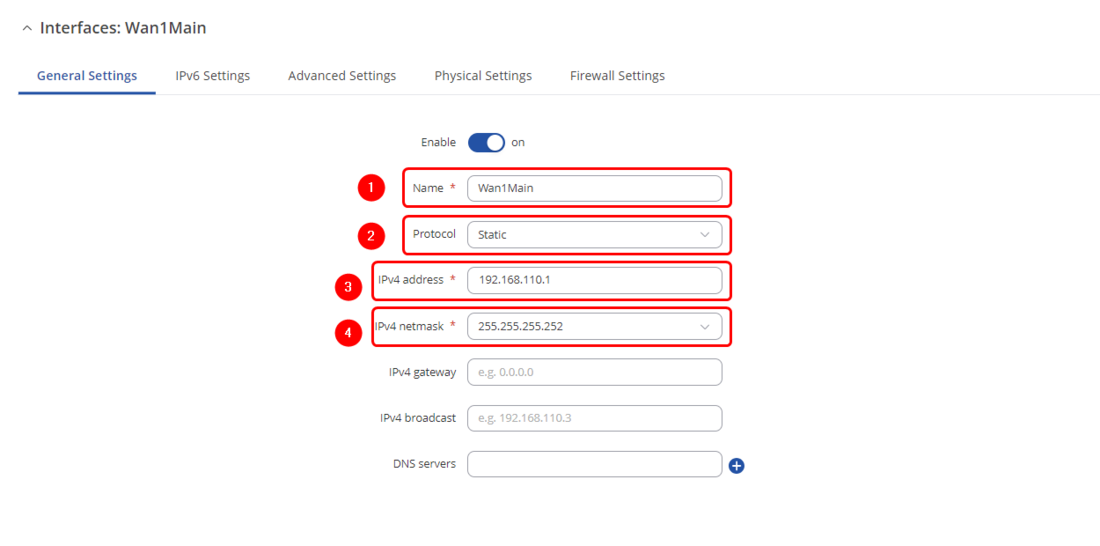
Physical Settings
Make the following changes:
- Select interface: eth0.192

Creating And Configuring WAN 2 Interface
Add new WAN by clicking ![]() and Make following changes to new interface configurtion:
and Make following changes to new interface configurtion:
General Settings
Make the following changes:
- Enter Name: Wan2Backup
- Select Protocol: Static
- Enter IPv4 address: 10.0.110.1
- Enter IPv4 net mask: 255.255.255.252
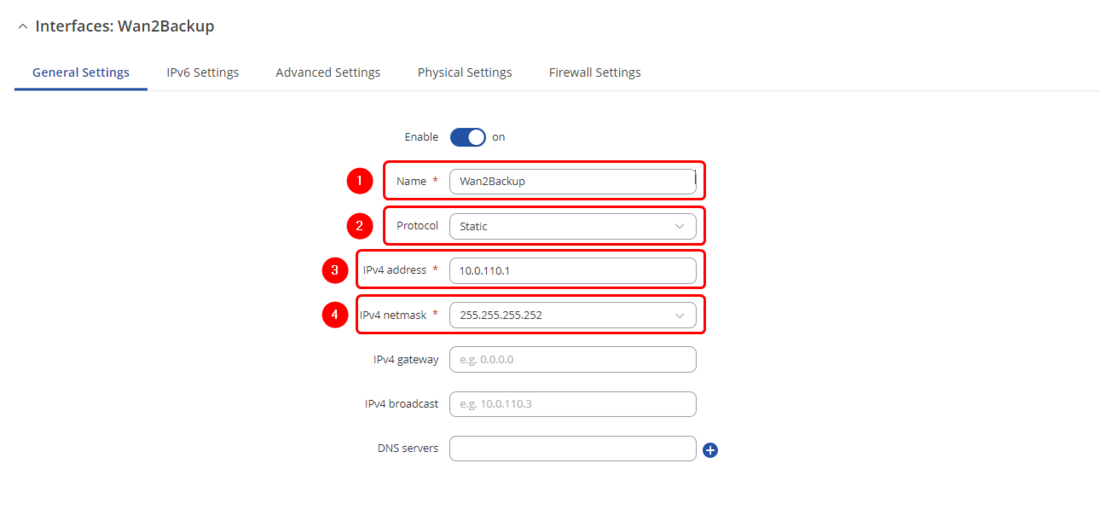
Physical Settings
Make the following changes:
- Select interface: eth0.10
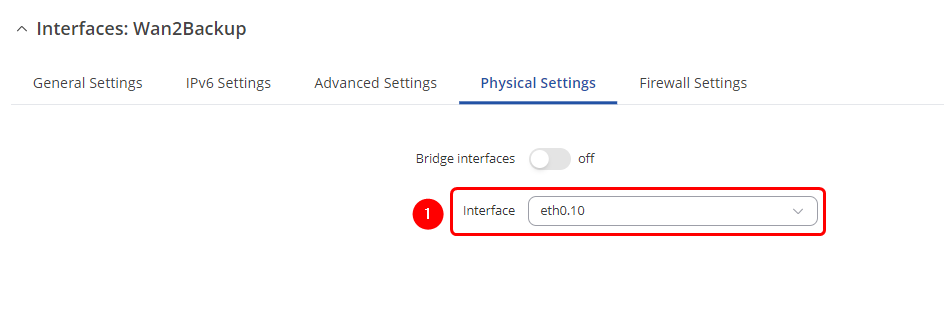
Creating And Configuring WAN 3 Interface
Add new WAN by clicking ![]() and Make following changes to new interface configurtion:
and Make following changes to new interface configurtion:
General Settings
Make the following changes:
- Enter Name: Wan3Backup
- Select Protocol: Static
- Enter IPv4 address: 172.16.110.1
- Enter IPv4 net mask: 255.255.255.252
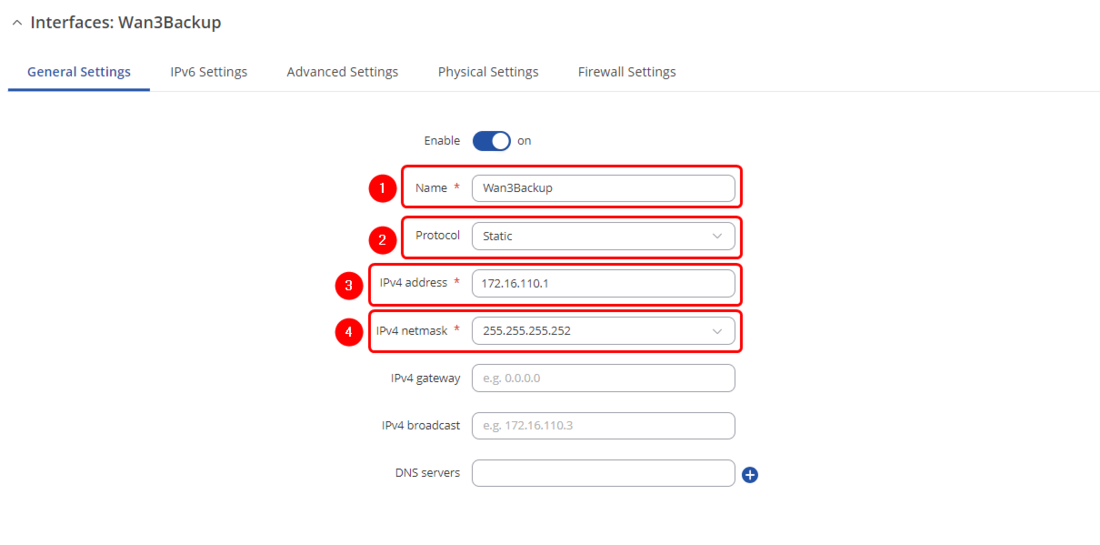
Physical Settings
Make the following changes:
- Select interface: eth0.172
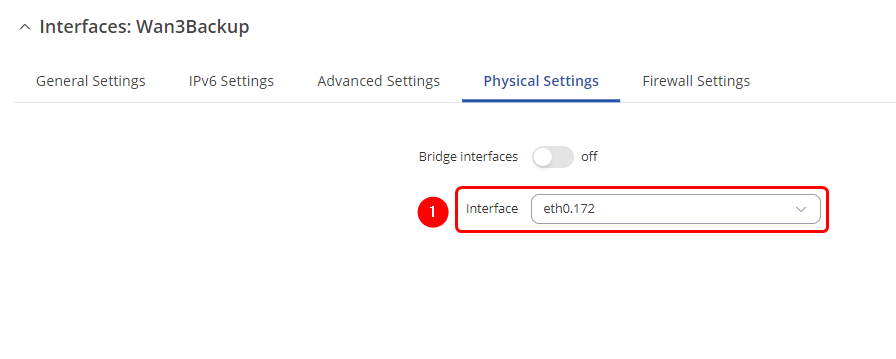
OSPF Configuration
Open router‘s WebUI and navigate to Network → Routing → Dynamic routes → OSPF configuration:
OSPF - Global Settings
Make following changes:
- Enable Service: on
- Enable Vty: on
- Enter Router ID: 192.168.110.1
- Select External Route: Default
- Select Redistribution Options: Connected
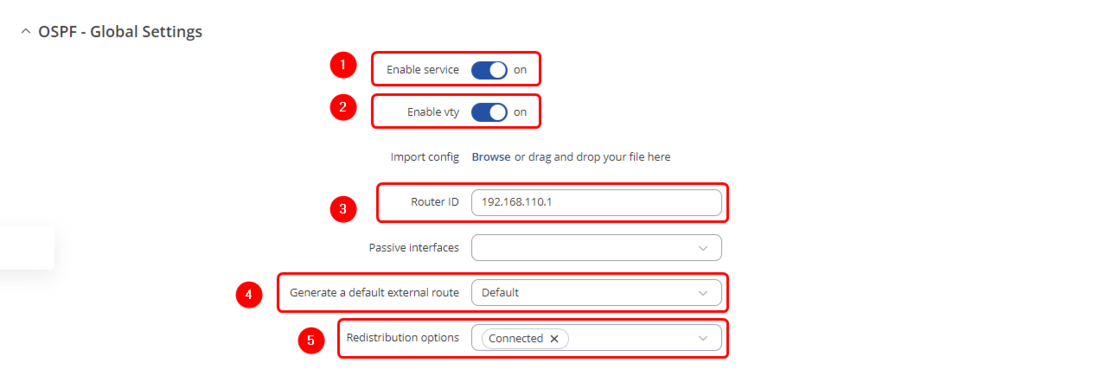
OSPF interfaces
Add new OSPF interface for each WAN interface created by clicking ![]()
Make following changes to new interfaces:
- Select Interface: eth0.192 (WanMAIN) | Enable Interface: on
- Select Interface: eth0.10 (Wan2Backup) | Enable Interface: on
- Select Interface: eth0.172 (Wan3Backup) | Enable Interface: on

OSPF area
Add new OSPF area for each WAN interface by entering the area name and clicking ![]()
Make following changes to the areas:
- Name: First | Area: 1005 | Stub: off | on
- Name: Second | Area: 1004 | Stub: off | on
- Name: Third | Area: 1003 | Stub: off | on
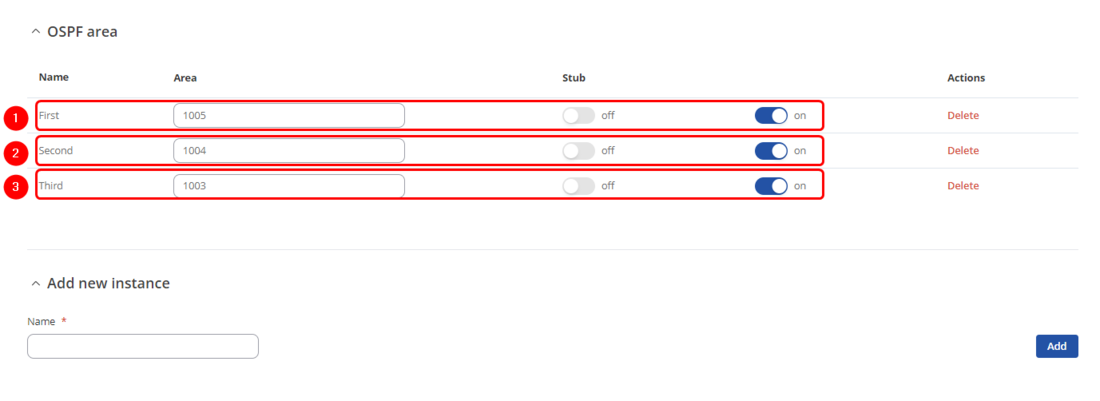
OSPF networks
Add new OSPF network for each WAN interface by entering the area name and clicking ![]()
Make following changes to the netwroks:
- Name: WAN1 | Network: 192.168.110.0/30 | Area: First | on
- Name: WAN2 | Network: 10.0.110.0/30 | Area: Second | on
- Name: WAN3 | Netwrok: 172.16.110.0/30 | Area: Third | on
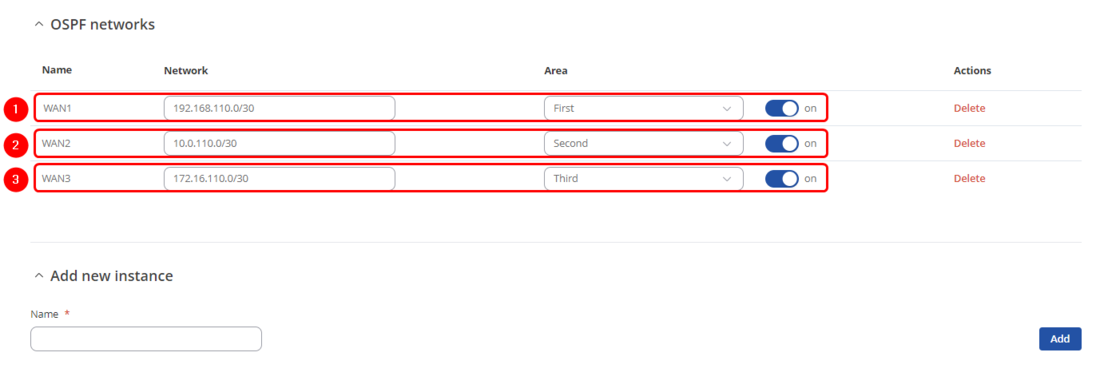
Router 2 Configuration
VLAN Configurtion
Open router‘s WebUI and navigate to Network → VLAN → Port Based configuration:
Port based VLAN
Add new VLANs by clicking ![]() and Make following changes to 3 new VLANS:
and Make following changes to 3 new VLANS:
- VLAN ID: 192 | lan1: Untagged | Lan2: Off | Lan3: Off
- VLAN ID: 10 | lan1: Off | Lan2: Untagged | Lan3: Off
- VLAN ID: 172 | lan1: Off | Lan2: Off | Lan3: Untagged
WAN Interface Configurtion
Open router‘s WebUI and navigate to Network → WAN → WAN interfaces configuration:
Creating And Configuring WAN 1 Interface
Add new WAN by clicking ![]() and Make following changes to new interface configurtion:
and Make following changes to new interface configurtion:
General Settings
Make the following changes:
- Enter Name: Wan1Main
- Select Protocol: Static
- Enter IPv4 address: 192.168.110.2
- Enter IPv4 net mask: 255.255.255.252
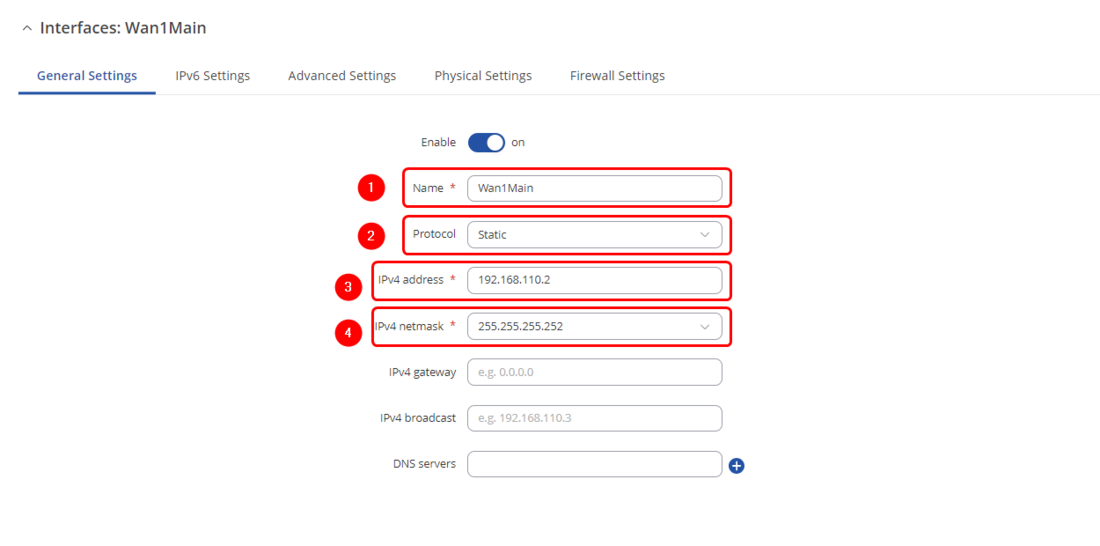
Physical Settings
Make the following changes:
- Select interface: eth0.192

Creating And Configuring WAN 2 Interface
Add new WAN by clicking ![]() and Make following changes to new interface configurtion:
and Make following changes to new interface configurtion:
General Settings
Make the following changes:
- Enter Name: Wan2Backup
- Select Protocol: Static
- Enter IPv4 address: 10.0.110.2
- Enter IPv4 net mask: 255.255.255.252
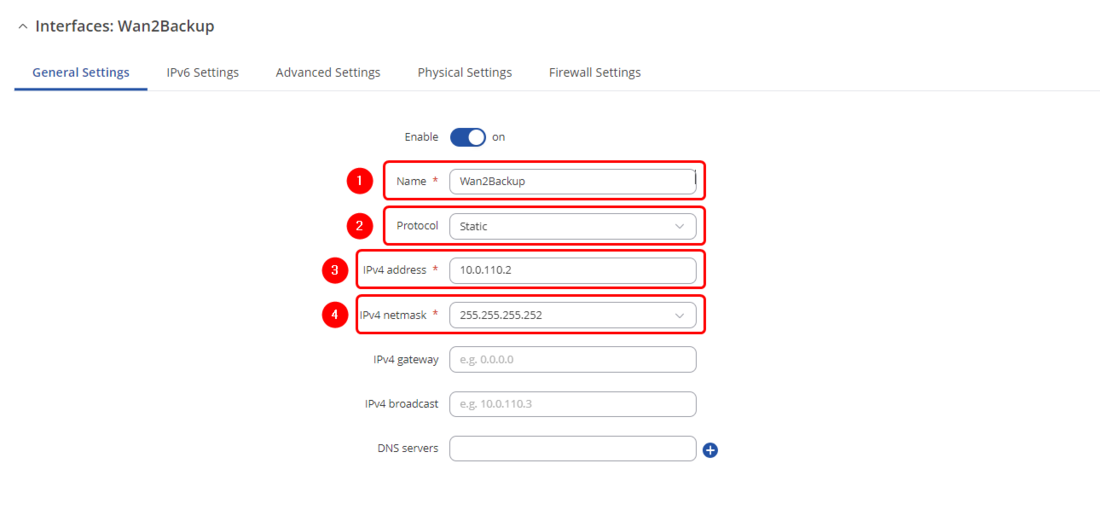
Physical Settings
Make the following changes:
- Select interface: eth0.10

Creating And Configuring WAN 3 Interface
Add new WAN by clicking ![]() and Make following changes to new interface configurtion:
and Make following changes to new interface configurtion:
General Settings
Make the following changes:
- Enter Name: Wan3Backup
- Select Protocol: Static
- Enter IPv4 address: 172.16.110.2
- Enter IPv4 net mask: 255.255.255.252
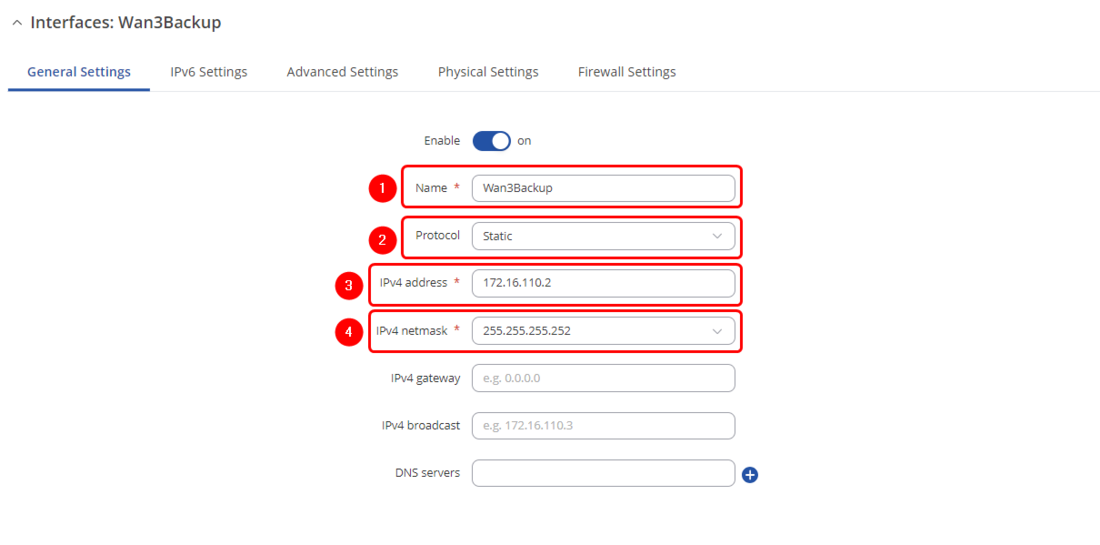
Physical Settings
Make the following changes:
- Select interface: eth0.172

OSPF Configuration
Open router‘s WebUI and navigate to Network → Routing → Dynamic routes → OSPF configuration:
OSPF - Global Settings
Make following changes:
- Enable Service: on
- Enable Vty: on
- Enter Router ID: 192.168.110.2
- Select External Route: Default
- Select Redistribution Options: Connected
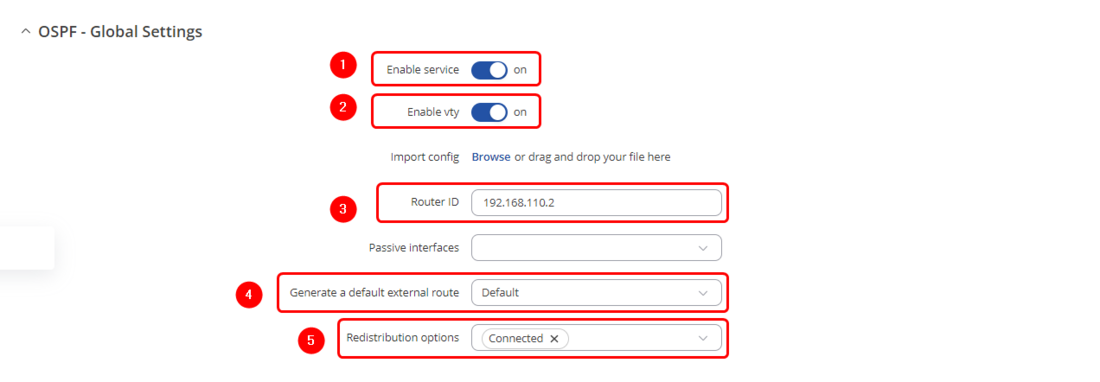
OSPF interfaces
Add new OSPF interface for each WAN interface created by clicking ![]()
Make following changes to new interfaces:
- Select Interface: eth0.192 (WanMAIN) | Enable Interface: on
- Select Interface: eth0.10 (Wan2Backup) | Enable Interface: on
- Select Interface: eth0.172 (Wan3Backup) | Enable Interface: on

OSPF area
Add new OSPF area for each WAN interface by entering the area name and clicking ![]()
Make following changes to the areas:
- Name: First | Area: 1005 | Stub: off | on
- Name: Second | Area: 1004 | Stub: off | on
- Name: Third | Area: 1003 | Stub: off | on

OSPF networks
Add new OSPF network for each WAN interface by entering the area name and clicking ![]()
Make following changes to the networks:
- Name: WAN1 | Network: 192.168.110.0/30 | Area: First | on
- Name: WAN2 | Network: 10.0.110.0/30 | Area: Second | on
- Name: WAN3 | Netwrok: 172.16.110.0/30 | Area: Third | on

Configuration Testing
If everything was set up correctly, we should see routes to the second network through the main link in the routing table:
Let us simulate Main link failure by disconnecting the cable and see how that affects routes to the second network:
As we can see, dynamic routing automatically switched to the next available route.
Testing Communication Between LAN Devices
Let us connect a LAN device to each of the routers and see if they can communicate with each other, for this example, we will connect laptop to the first router and another laptop to the second router:
- Laptop 1 IP: 192.168.1.220
- Laptop 2 IP: 192.168.2.5
Let us run a ping command from the first laptop to the second and disconnect the Main link cable midway through:
We can see that after a short delay, laptop on the second router continued communication, which means dynamic routes are being set correctly.



